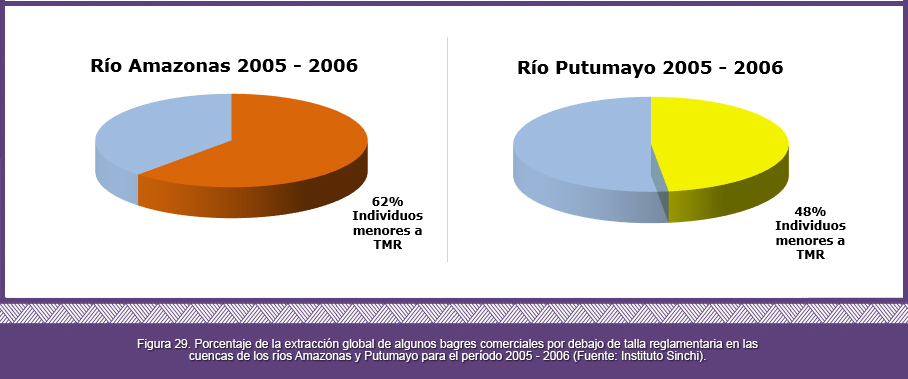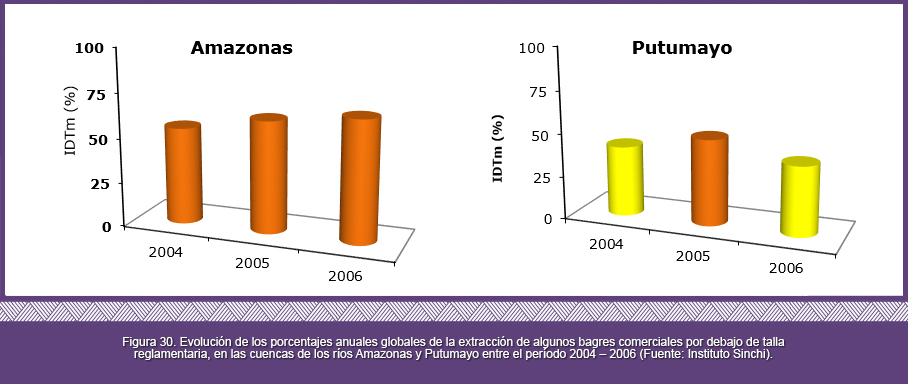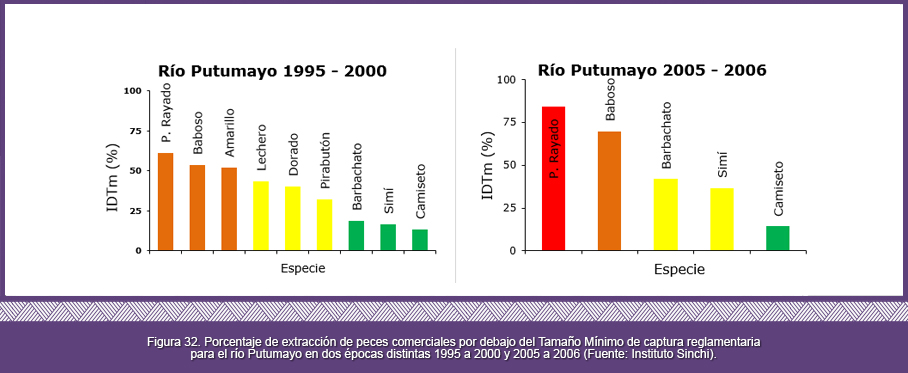The second update of the indicator of fish catches below legal sizes was made in the Putumayo and Amazon basins, based on the continuous records owned by the Sinchi Institute; 2004 data was also linked. In general terms, the results of this update continues to show an overall increase in the negative impact of fishing for the Amazon River, which went from 33% in 2002 to 52% in 2004 and in 2006 reached 63%, which maintains it in the category of high impacted resource. While in the Putumayo basin, the values remained relatively constant (Figure 29).

When data for the years 2004 to 2006 is analyzed on a year to year basis, the trend of alarming growth of the indicator for the Amazon River and the fluctuations that occurred in the Putumayo River can be seen (Figure 30).

In order to be able to discern the fluctuation in the behavior of the average sizes of catch in comparison with the legal sizes, it is necessary to take into account the fishing gear and their selectivity with respect to the size of the fish that fall into them.
The most common fishing gears can be grouped into lines (ropes) and nets, whose difference in use between one group and another is given especially by the geoforms of the riverbed in each location, the cost of the rigs and their operation, as well as the process of demand and commercialization of the catfish. For the Putumayo basin the most used and most representative arts are those that are grouped as ropes, which is why the bulk of the individuals captured within these gears are found, and for the Amazon, most of the catches are made with nets, except for The Simi that´s captured with hand lines with small hooks. A base of the catch averages of these groups for the main species of catfish can be summarized in the following table:

Of the 11 species reviewed in the 2004 update, 9 were able to be analyzed in the Amazon River and 5 in the Putumayo (which had not been updated since 2000). At the same time, species that had a high negative impact continued in that position for the Amazon, while others went from medium to high impact and vice versa; and species with low impact appeared more affected (Figure 31).

In the case of Putumayo, there was an increase in the negative pressure on catfish fishing analyzed with respect to the last decade, with the exception of Ajuar for which fishing has had a low negative impact on the region; for the other species, the number of records did not allow for the update of the indicator (Figure 32).

For the Amazon basin, the catches of dorado near Leticia corresponded to adult specimens, especially to females that increase the average values of the length of capture. But when considering the samples of individuals captured long distances from Leticia (300 - 500 km downstream), which are stored in Leticia collection centers, these figures decrease. Therefore we can state that the dynamics of local fishing does not generate major negative impacts for this catfish, but the processes of regional demand and commercialization along the Amazon River mean that fishery as a whole negatively impacts this resource.
The case of Goslinia platynema in both rivers, reflects the apprehension of small animals that generates smaller sizes, captured with hooks. The decrease in average sizes is due to a greater presence of males, which, being smaller, reduce the average size. But it is clear that in both basins the pressure increased.
The situation of Pseudoplatystoma fasciatum, one of the two species of pintadillos that in Amazonia have become the most commercialized resource, followed by dorado, is worrisome. Although for the Amazon basin there was a slight decrease in the negative percentage of the high impact on the species, unfortunately for the Putumayo River this harmful result increased.
The simi is a species that has been consolidated as a catfish of high commercial importance with annual increases since 1998 and is currently the fourth most commercialized and one to which permanent efforts to capture are devoted. Given its high voracity that makes it easy prey and the fishing process using small hooks and even with hands, the proportion of animals captured of small size is very high, which is reflected in the negative evolution of the size indicator for both rivers .
It can not be ignored that the enormous demand for pintadillos and simí, which are quite similar to the pintadillos and capacetas of the Magdalena basin and therefore the different strategies used to capture these species in different environments, have been negatively affecting these species.
Without ignoring the socio-economic importance of fishing in the Amazon, the immediate processes of fishery management and its applicability should lean towards the ratification and / or adjustment of the current permitted catch sizes, as well as to specify the gear that can be used in fishing, according to their selectivity for the species and the sex of the individuals.
But the future of the activity and the perpetuation of species will not depend only on the fisheries management through sizes. In that order, we should be aware that commercial fishery collects migratory species that spend part of their life cycles in the border areas. Thus, the recommendations of the various scientific studies conducted on catfish fishing have an effect, the entities in charge of the management of the fishery resource should lean towards a balanced and equitable regional regulation on the part of the border countries (Colombia, Brazil and Peru), that ensure their sustainability, profitability and competitiveness.